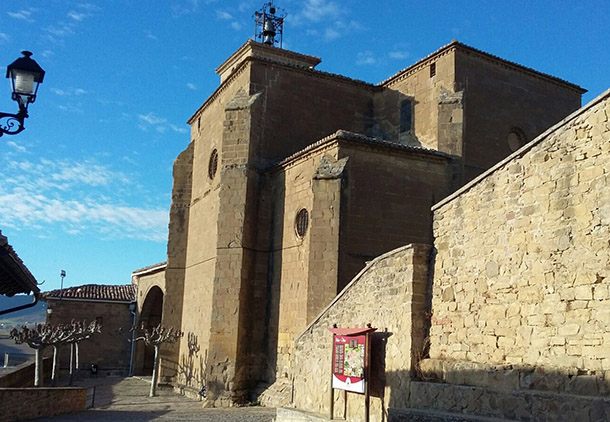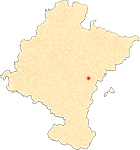Parish Church of San Pedro de Aibar
Introduction
The parish church of San Pedro de Aibar is, without a doubt, one of the architectural landmarks of Navarrese Romanesque architecture. Its construction was documented in 1146 thanks to an exchange between García Cristóbal and the abbot Pedro de Aibar, the church of San Pedro is one of those churches that in the second third of the 12th century disseminated the forms tested and applied in the Romanesque cathedral of Pamplona. It is not in vain that some of the characteristics of the Iruñea cathedral, such as the three naves, were also transferred to this locality. In fact, the parish church of Aibar is still a significant example of Navarrese Romanesque architecture today, despite the suppression of the chevet in the 16th century. It is the only Romanesque building with three naves preserved today with the forms typical of its time, as other examples with three naves, such as Santa María de Muskilda and San Miguel de Izaga, have a more rural character, with simplified forms and belong to the end of the century. It is also one of the oldest Romanesque churches in Navarre with monumental sculpture.
But the parish church of Aibar is not only notable for the quality of its Romanesque architecture. In the 16th century, it underwent a Renaissance extension with the construction of the Wayside Cross and the main chapel, as can be seen in its tierceron vaults and the portico with its elegant façade, which assimilated some of the most innovative features of the time. The church also treasures other pieces of great wealth such as the 14th century Gothic Santo Cristo, the Romanesque high altarpiece from the last quarter of the 17th century and the organ from the end of the 18th century, as well as notable pieces of silverware such as a superb Gothic monstrance from the last third of the 15th century and an 18th century Hispano-American ciborium. In the field of textiles, it is worth mentioning a lavish crimson robe from the late 18th century.
ARAGONÉS, E., "El románico de Sangüesa", El Arte en Navarra, volume 1, Pamplona, Diario de Navarra, 1994, pp. 65-80.
FERNÁNDEZ GRACIA, R., ANDUEZA UNANUA, P., AZANZA LÓPEZ, J. and GARCÍA GAINZA, M.C., El arte del Barroco en Navarra, Pamplona, Gobierno de Navarra, 2014.
FERNÁNDEZ GRACIA, R., ECHEVERRÍA GOÑI, P.L. and GARCÍA GAINZA, M.C., El arte del renacimiento en Navarra, Pamplona, Gobierno de Navarra, 2005.
FERNÁNDEZ-LADREDA, C., MARTÍNEZ DE AGUIRRE, J. and MARTÍNEZ ÁLAVA, C.J., El arte románico en Navarra, Pamplona, Gobierno de Navarra, 2004.
FERNÁNDEZ-LADREDA, C., MARTÍNEZ ÁLAVA, C.J., MARTÍNEZ DE AGUIRRE, J. and LACARRA DUCAY, M.C., El Arte Gótico en Navarra, Pamplona, Gobierno de Navarra, 2015.
GARCÍA GAINZA, M.C. and ORVE SIVATTE, M., Catalog Monumental de Navarra. Merindad de Sangüesa, volume IV*, Pamplona, Government of Navarra, 1989.
GARCÍA GAINZA, M.C., La Escultura Romanista en Navarra, Pamplona, Government of Navarre, 1986.
HEREDIA MORENO, M.C., ORVE SIVATTE, M. and ORVE SIVATTE, A., Arte hispanoamericano en Navarra. Silver, painting and sculpture. Pamplona, Government of Navarre, 1992.
IZIZ ELARRE, R., Aibar-Oibar. Historia, volume 1, Tafalla, Altaffaylla Kultur Taldea, 2008.
LARRIÓN, J.L., "Romerías", Temas de Cultura Popular, number 42, Pamplona, Diputación Foral de Navarra, 1969.
LEOJENDIO, L.M., "pathway del Románico", Temas de Cultura Popular, number 85, Pamplona, Diputación Foral de Navarra, 1975.
SAGASETA, A. and TABERNA, L. Órganos de Navarra, Pamplona, Government of Navarre, 1985.












